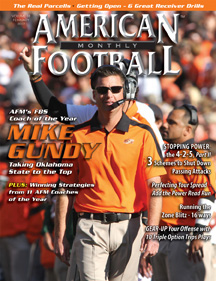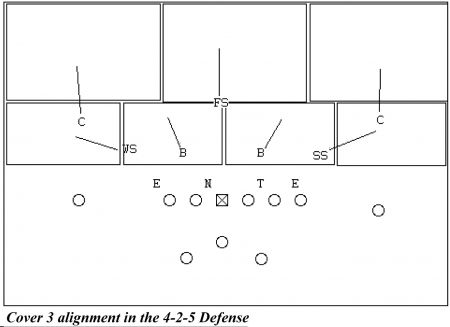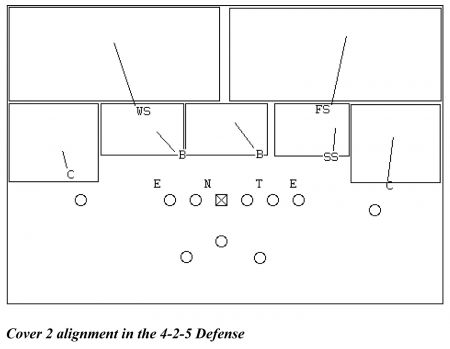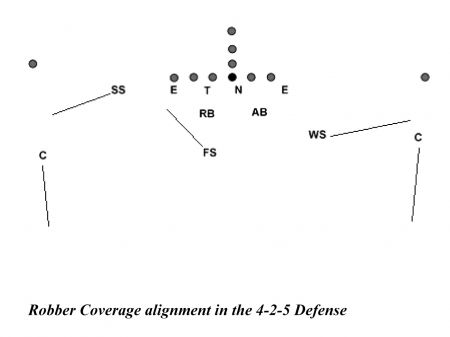Article CategoriesAFM Magazine
|
Stopping Power – Part II – Basic Coverages in the 4-2-5by: Frank DiCoccoAssistant Coach and Player Development Director, Stillman College © More from this issue Due to its similarities to the 4-4, the most basic coverage in the 4-2-5 scheme is cover 3. In line with the “bend-but-don’t-break” approach, cover 3 is a three-deep zone scheme that keeps the football in front of the defenders and forces offenses to execute long drives in order to score. The base alignment of the 4-2-5 makes playing cover 3 a natural fit for the scheme, making it equally easy to teach, install, and execute. The presence of five defensive backs makes it possible to easily transition into “Cloud” and “Sky” variations of the coverage as well. In a traditional cover 3 scheme, the free safety plays the deep middle of the field, with each cornerback having deep-third responsibilities. The strong and weak safeties have responsibility for the flat areas. In “Cloud” coverage, the cornerbacks would occupy the flat areas, while the strong and weak safeties would play over the top of them, manning the deep third area on their respective sides of the field. The free safety would maintain his deep middle responsibilities. “Cloud” coverage can often be played on both sides of the field simultaneously, or it can be utilized on one particular side – weak or strong, wide or boundary side – of the field. Typically, this brand of coverage is employed to one side, with the opposite cornerback locked in man coverage on the back-side. In the “Sky” variation of cover 3, the roles of the corners and safeties would be reversed. The cornerbacks would have responsibility for the deep third, with the safeties occupying the flat areas. “Sky” is most often utilized on one side of the field. For example, a “Cover 3, Sky-Weak” call might be made in order to create different looks on each side of the field. This is an effective tactic for defending “coverage-beater” combinations from opposing offenses. The “Sky” scheme can also be a great complement to the zone blitz, as it puts a defender in the flat areas (and often, the throwing lanes to the flat areas) taking away sight adjustments and hot reads that might negate the blitz (See Diagram 1).
In cover 2, however, he would play a deep half of the field, with one of the other safeties assuming responsibility for the other deep half. The cornerbacks would become flat defenders, with the linebackers and other safety accounting for the hook-to-curl and middle-hole areas of the field (in some combined fashion). Once again, the flexibility of the 4-2-5’s personnel allows for creativity in the variations of cover 2 schemes. Cornerbacks can easily be vacated to the deep half zone on their respective sides of the field, with either the strong or weak safety quickly buzzing to the flat areas (See Diagram 2).
From the 2-high-safety alignment, cover 4 (or quarters coverage) also becomes a simple and effective scheme to employ. In cover 4, just as with the cover 2 look, the free and strong safeties would play a deep half coverage, while the corners would have the flats, and the weak safety would account for the hook-to-curl area. The 2-safety alignment frees up the weak safety to matchup with a slot receiver in either zone or man coverage, essentially becoming a nickel back. Due to his inherent athleticism as a defensive back, this makes aligning to three and four-receiver sets (especially to trips) much more effective than in a 4-3 or 3-4 scheme, where you likely would be asking a linebacker to engage in coverage. Robber coverage is essentially a “rover” type of coverage, with a single-safety alignment lending itself naturally to this scheme as well. Robber coverage can be employed against a number of different formations. However, its most effective usage typically comes against the tight end set. Versus a double-tight formation, the coverage is equally effective, and often can be played with both the strong and weak safeties playing the role of robber. By combining this approach with a cover 1 scheme deep, the strong and weak safeties are able to walk down into the box, creating an 8-man front to help stop the run and creating various opportunities to pressure the quarterback (See Diagram 3).
Due to its ability to occupy zones with unexpected defenders, robber coverage provides a great background to the many zone-blitz packages that the 4-2-5 has to offer. “The robber coverage is really one of our most effective coverages,” said Ed Walker, Linebackers Coach at Stillman College. “It is basically a cover 1 defense, where we like to blitz one of our inside linebackers and drop another into man coverage (usually with a running back). The strong safety becomes the robber defender, roaming the middle-to-underneath area, and reading the number-2 receiver to his side.” The design is meant to create the impression of a man blitz, which would typically vacate the underneath-middle zone of the field. However, with the strong safety (or weak safety, depending on the side) free to roam that area, it adds a defender to a zone where the quarterback likely did not anticipate there being one. Due to the defense’s versatility and personnel flexibility, the variety of coverages that can be played from in 4-2-5 scheme are virtually unlimited. From a 2-high safety look, all types of zone schemes can be effective, including cover 2, cover 4 (quarters coverage), and bracket coverage (cover 2 to one side, and cover 4 to the other). Man coverage techniques can also be utilized, including (cover 2) man-under, press, and bump-and-run techniques. From a single high safety look, both man and zone schemes may be employed. Cover 3 is the most natural and basic of these. However, a true cover 2 or cover 4 may also be implemented with a simple pre-snap roll in coverage. Cover 1 (or man free), cover 0 (or true man) variations may also be utilized with ease. Both cover 1 and cover 0 allow for added pressure in the passing game, providing the opportunity to unleash additional defenders in any number of blitz packages. Depending on the personnel you have in the defensive secondary - particularly at the cornerback position - you can play as safely or aggressively as you want. Obviously, the more talented your cornerbacks, the more man coverage you will have at your disposal and be able to employ. This creates a huge advantage when it comes to stopping the run, as it allows you to commit 8, or even 9, defenders to stopping the offense’s running attack. It also allows you to construct an almost infinite array of coverage possibilities, while giving you the ability to stem and sugar pre-snap, as well as to disguise coverages and roll coverages post-snap. Additionally, this type of versatility gives you the opportunity to throw a virtually unlimited amount of blitzes and zone blitzes at your opponent. Much of this is determined by the quality of your defensive backs, and specifically your corners. The better your cornerback play, the more creative you can afford to be with your play calling. |
|
| HOME |
MAGAZINE |
SUBSCRIBE | ONLINE COLUMNISTS | COACHING VIDEOS |
Copyright 2025, AmericanFootballMonthly.com
All Rights Reserved







